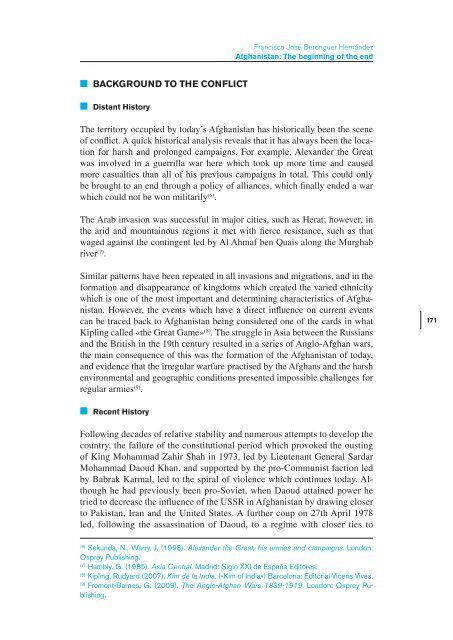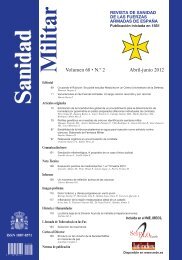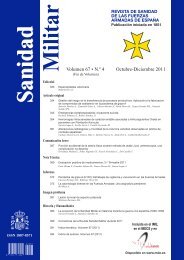GEOPOLITICAL OVERVIEW OF CONFLICTS 2011 - Portal de ...
GEOPOLITICAL OVERVIEW OF CONFLICTS 2011 - Portal de ...
GEOPOLITICAL OVERVIEW OF CONFLICTS 2011 - Portal de ...
Create successful ePaper yourself
Turn your PDF publications into a flip-book with our unique Google optimized e-Paper software.
Francisco José Berenguer Hernán<strong>de</strong>z<br />
Afghanistan: The beginning of the end<br />
■■<br />
BACKGROUND TO THE CONFLICT<br />
■■<br />
Distant History<br />
The territory occupied by today’s Afghanistan has historically been the scene<br />
of conflict. A quick historical analysis reveals that it has always been the location<br />
for harsh and prolonged campaigns. For example, Alexan<strong>de</strong>r the Great<br />
was involved in a guerrilla war here which took up more time and caused<br />
more casualties than all of his previous campaigns in total. This could only<br />
be brought to an end through a policy of alliances, which finally en<strong>de</strong>d a war<br />
which could not be won militarily (6) .<br />
The Arab invasion was successful in major cities, such as Herat; however, in<br />
the arid and mountainous regions it met with fierce resistance, such as that<br />
waged against the contingent led by Al Ahmaf ben Quais along the Murghab<br />
river (7) .<br />
Similar patterns have been repeated in all invasions and migrations, and in the<br />
formation and disappearance of kingdoms which created the varied ethnicity<br />
which is one of the most important and <strong>de</strong>termining characteristics of Afghanistan.<br />
However, the events which have a direct influence on current events<br />
can be traced back to Afghanistan being consi<strong>de</strong>red one of the cards in what<br />
Kipling called «the Great Game» (8) . The struggle in Asia between the Russians<br />
and the British in the 19th century resulted in a series of Anglo-Afghan wars,<br />
the main consequence of this was the formation of the Afghanistan of today,<br />
and evi<strong>de</strong>nce that the irregular warfare practised by the Afghans and the harsh<br />
environmental and geographic conditions presented impossible challenges for<br />
regular armies (9) .<br />
171<br />
■■<br />
Recent History<br />
Following <strong>de</strong>ca<strong>de</strong>s of relative stability and numerous attempts to <strong>de</strong>velop the<br />
country, the failure of the constitutional period which provoked the ousting<br />
of King Mohammad Zahir Shah in 1973, led by Lieutenant General Sardar<br />
Mohammad Daoud Khan, and supported by the pro-Communist faction led<br />
by Babrak Karmal, led to the spiral of violence which continues today. Although<br />
he had previously been pro-Soviet, when Daoud attained power he<br />
tried to <strong>de</strong>crease the influence of the USSR in Afghanistan by drawing closer<br />
to Pakistan, Iran and the United States. A further coup on 27th April 1978<br />
led, following the assassination of Daoud, to a regime with closer ties to<br />
(6)<br />
Sekunda, N., Warry, J. (1998). Alexan<strong>de</strong>r the Great, his armies and campaigns. London:<br />
Osprey Publishing.<br />
(7)<br />
Hambly, G. (1985). Asia Central. Madrid: Siglo XXI <strong>de</strong> España Editores.<br />
(8)<br />
Kipling, Rudyard (2007). Kim <strong>de</strong> la India. («Kim of India») Barcelona: Editorial Vicens Vives.<br />
(9)<br />
Fremont-Barnes, G. (2009). The Anglo-Afghan Wars 1839-1919. London: Osprey Publishing.
















